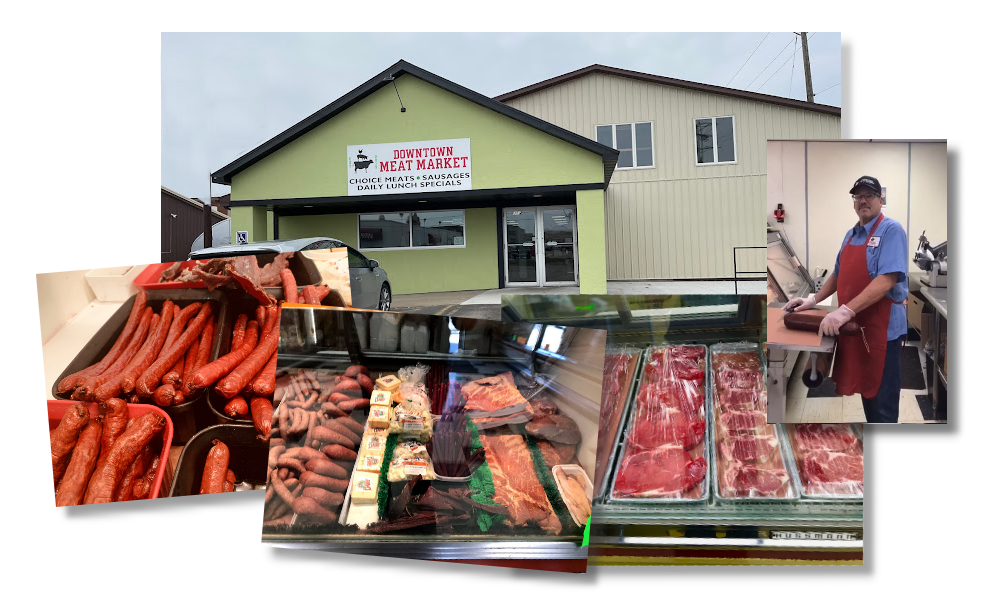Discover Fresh Cuts at Bagley Farms Meat Market Edwardsville IL for Your Next barbeque
Discover Fresh Cuts at Bagley Farms Meat Market Edwardsville IL for Your Next barbeque
Blog Article
Reveal the Art of the Butcher's Cut in a Modern Meat Market
In the ever-evolving landscape of modern-day meat markets, the butcher's cut has actually transcended its conventional origins, merging old-time workmanship with modern practices. What really sets the modern butcher apart is their capacity to forge a deeper connection in between consumers and the origins of their meat.
Advancement of Butchery Strategies
The evolution of butchery techniques reflects an abundant tapestry of innovation and adjustment driven by innovations in modern technology, modifications in customer need, and a deeper understanding of meat science. Historically, butchery was a craft gave through generations, with techniques honed over centuries to make best use of yield and flavor. The commercial transformation ushered in automation, changing conventional techniques and making it possible for large processing.
The mid-20th century saw butchery strategies even more improved by scientific insights right into muscle biology and meat aging, enhancing both inflammation and preference. Developments like vacuum cleaner packaging and refrigeration extended product shelf-life, enabling butchers to branch out offerings and enhance quality assurance. This duration additionally marked the rise of customized tools, such as band saws and meat slicers, which enhanced accuracy and performance in meat processing.

Digital systems now help in monitoring pet provenance and enhancing cuts to meet specific consumer preferences. Furthermore, a resurgence in artisanal butchery has actually emerged, blending traditional abilities with modern expertise to cater to consumers seeking moral and sustainable meat alternatives.
Comprehending Meat Cuts
Recognizing the complexities of meat cuts is vital for both butchers and customers seeking quality and value. Each cut originates from a various component of the pet, passing on unique tastes, textures, and food preparation methods - bagley farms meat market edwardsville il. Proficiency of these differences not only enhances culinary experiences but also optimizes the utility of each carcass. For butchers, accurate cuts show ability and respect for the craft, making certain marginal waste and optimum yield.

Comprehending muscle mass composition is vital; muscle mass used more regularly by the animal have a tendency to be harder and are best suited for slow food preparation techniques, while less-used muscular tissues, like those discovered in the loin, are a lot more tender and ideal for grilling or roasting. Experience with these differences encourages customers to make enlightened options, improving their culinary ventures.
Choosing Top Quality Meat
Choosing the right meat includes even more than simply picking an aesthetically appealing piece from the display. bagley farms meat market edwardsville il. The art of picking quality meat calls for a discerning eye and understanding of specific features that signify quality and excellence. Firstly, focus on the color; beef needs to have a bright, cherry-red shade, while lamb ought to exhibit a soft pink tone, and pork a pale pink. This shows the meat is fresh and hasn't been revealed to oxygen for too lengthy.
Secondly, think about the marbling, which describes the white streaks of fat within the muscular tissue. Correct marbling is a key indicator of tenderness and flavor, as it melts throughout food preparation, boosting the meat's juiciness. Remember, higher marbling typically associates with exceptional top quality cuts, such as USDA Prime.
Appearance is an additional crucial aspect; meat must really feel strong to the you could look here touch, not slimed or extremely soft. In addition, bear in mind the fragrance. Fresh meat must have a tidy, neutral smell, without any type of sour or off-putting odors.
Matching Cuts With Cooking Methods

Alternatively, tougher cuts like brisket and chuck roast are rich in collagen, which breaks down into gelatin when cooked slowly. These cuts are suitable for braising or slow-moving roasting, enabling the meat to tenderize in time and establish deep, intricate tastes. Similarly, cuts such as short ribs and pork shoulder prosper with slow-cooking techniques, where prolonged cooking times change their durable appearances into succulent meals.
Lamb shanks and oxtail, which call for long term food preparation to soften, are perfect candidates for stewing or sluggish simmering. These techniques coax out abundant, passionate tastes while keeping dampness. By understanding the special features of each cut, cooks and home chefs alike can boost their cooking productions, ensuring each dish is both satisfying and memorable.
The Butcher's Role Today
Navigating the progressing landscape of the modern meat market, the butcher's duty today prolongs past simple prep work of cuts. Contemporary butchers are culinary craftsmens, teachers, and supporters for sustainable techniques.
Along with crafting precise cuts, butchers currently engage straight with customers, offering cooking suggestions and tailoring options to suit specific needs and choices. Their expertise in meat aging, marbling, and flavor accounts equips consumers to make educated choices, enhancing their cooking experiences. This customized service exemplifies the butcher's advancing role as a relied on advisor in the kitchen area.
Moreover, butchers are essential in minimizing waste, using entire animals to produce diverse items such as YOURURL.com sausages and supplies. This extensive technique not only values the pet however likewise straightens with contemporary sustainability objectives. This way, the modern butcher symbolizes both tradition and innovation, adapting to an ever-changing market while protecting the artistry and stability of their craft.
Verdict
The contemporary butcher's craft elaborately weaves traditional methods with modern-day developments, stressing sustainable methods and ethical sourcing. Proficiency in understanding diverse meat cuts and quality signs equips butchers to offer educated suggestions, aligning details cuts with optimum food straight from the source preparation approaches. This experience not only elevates culinary experiences however likewise strengthens the connection in between customers and the origins of their food. By honoring historic methods while embracing modern needs, the butcher's role remains essential in today's innovative meat market (bagley farms meat market edwardsville il).
Report this page